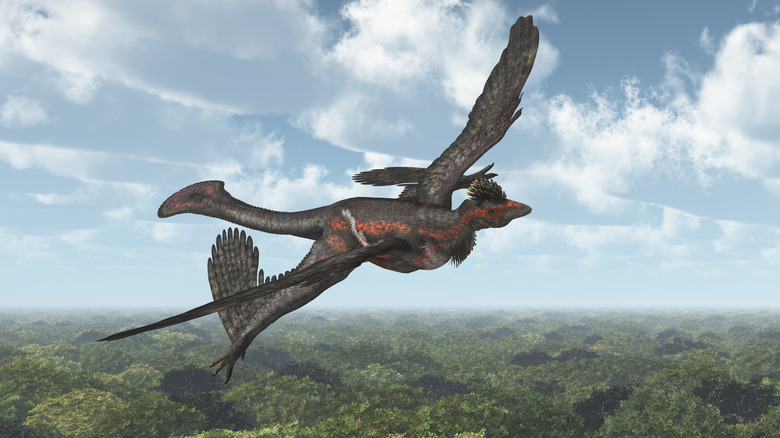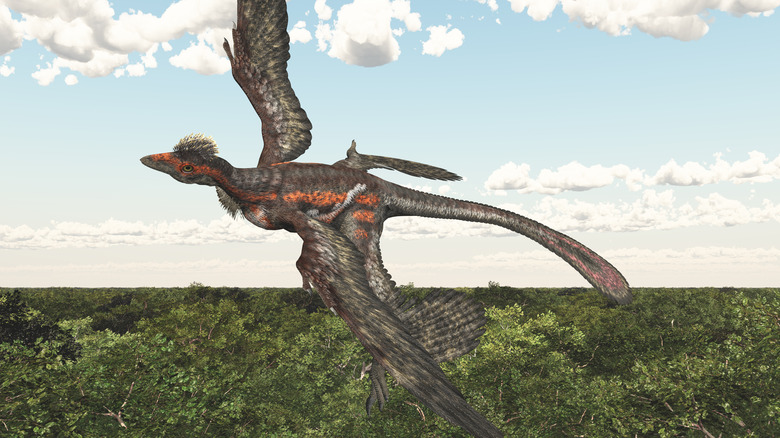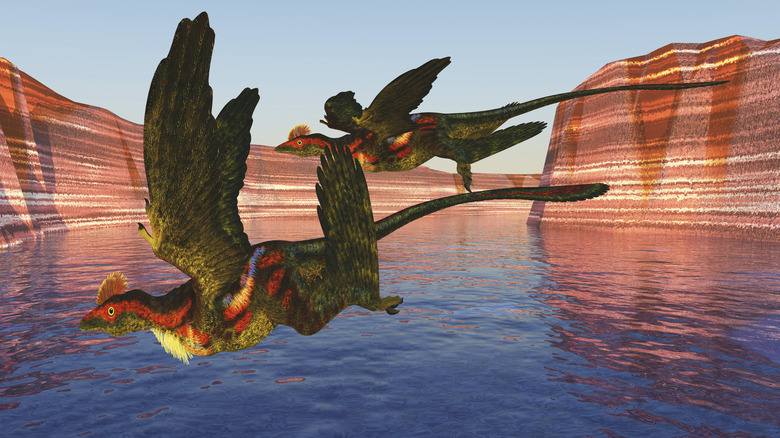One Of The Smallest Dinosaurs To Ever Exist Had Wings In An Unexpected Place
Anyone who's been following the big prehistoric discoveries of the last couple decades will know that dinosaurs don't look like they did in "Jurassic Park" any more. That is to say, they never actually did look like the giant reptiles in Steven Spielberg's action adventure classic — at least not all of them. Many dinosaurs actually had feathers, and in recent years it's become widely accepted that birds are actually the only modern descendent of dinos. But even with that fact well-established, there are still plenty of surprises left to discover and explain, as exemplified by one of the smallest dinosaurs to ever exist, which not only had feathers but four wings, including two on each of its hind legs.
The appropriately named Microraptor, which was thought to weigh between just two to three pounds, actually refers to a genus of small dinosaurs which had four wings. Three species have been identified from the hundreds of fossil specimens uncovered: Microraptor zhaoianus, Microraptor gui, and Microraptor hanqingi. All of these are considered non-avian dinosaurs (though some researchers maintain they were actually birds) which means while they have many traits that liken them to birds, they are in fact dinosaurs. A 2012 study published in Science also seemed to confirm that Microraptors likely had iridescent black feathers with a blue sheen.
But by far the most interesting aspect of the ancient creatures remains their wings. Experts still aren't certain how the Microraptor used its four wings, but research has suggested they may have glided between trees or perhaps used their plumage to propel them along as they ran. Some researchers have even suggested that Microraptors were capable of full flight.
What is a Microraptor?
When we think of raptors we might typically think of the vicious beasts that terrorized Sam Neil and his cohorts back in 1993. But the term "raptor" actually just refers to birds of prey. Today, birds including falcons and hawks are considered raptors, but back in the Early Cretaceous (one of the three time periods in which the dinosaurs lived), around 120 million years ago, the world was populated by long lost cousins of modern birds, representing some of the earliest raptors to ever exist. Microraptor was the smallest known species of these bird-like raptor dinosaurs, and one of the most fascinating.
The first Microraptor specimen actually emerged as part of the infamous dinosaur hoax known as "Archaeoraptor," when a Chinese farmer assembled his own fossil using parts of other dinosaur specimens during the early 2000s. After the hoax was revealed, the tail used in the forgery was matched to its original fossil, and the whole thing was described as Microraptor zhaoianus. Soon after, further specimens were discovered which showed Microraptors had primary feathers on their legs, before it was confirmed that these feathers actually represented full wings. That made the Microraptor entirely distinct from other bird-like dinos, including Archaeopteryx.
Ever since, researchers have worked to determine just what these wings were used for and whether Microraptors were capable of flight or not. While several studies have been carried out which provide compelling evidence that Microraptor used its wings to glide, some research has suggested that these small dinos could indeed fly.
Could Microraptors actually fly?
Since its discovery at the turn of the century, experts have been trying to determine how Microraptors used their four wings. Since no living bird has hind legs that act as fully developed wings, carrying out such a task is difficult. Most researchers think that Microraptors used their wings to glide around the prehistoric world much like a flying tree squirrel. A 2007 study published in the Proceedings of the National Academy of Sciences (PNAS) presented a possible method the creature used to extend its hind legs and glide between trees. This "undulatory phugoid" gliding involved the use of the tail to gain additional lift and stability during the glide, and the technique involved the use of all four wings.
But in 2014, a separate study published in the Public Library of Science looked at the species Microraptor gui and suggested the dino was capable of actual flight. Though it wouldn't have been very aerodynamic, this ancient cousin of modern birds seemed to have everything it needed to become fully airborne for extended periods.
More recent research, however, has suggested a different use for the animal's wings. A 2024 study published in Proceedings of the National Academy of Sciences involved looking at tracks left by a Microraptor. The tracks were oddly far apart, suggesting something else was at play; ultimately, that led the researchers to conclude that the creature displayed pre-avian aerial behavior, which essentially means the dino was likely flapping its wings as it ran, helping to propel it forward. Whatever the case, Microraptors provide a fascinating glimpse at the long lost time of feathered dinosaurs, and as more research is carried out we'll learn more about how flight itself developed.


